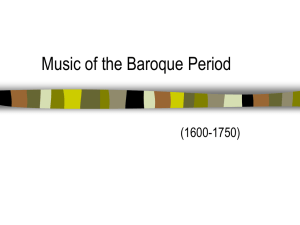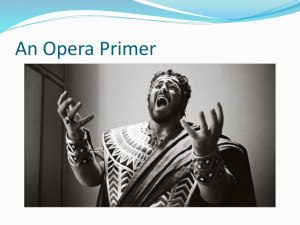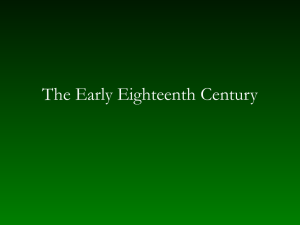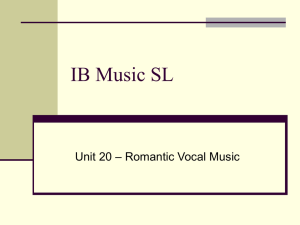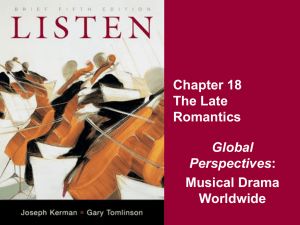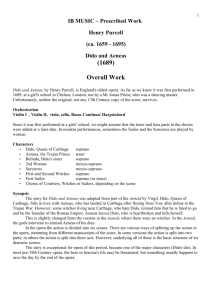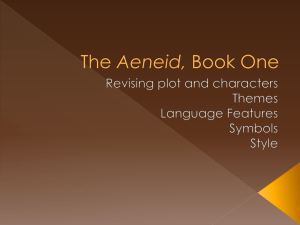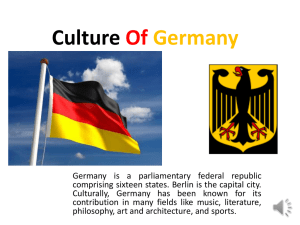dido notes part 2
advertisement
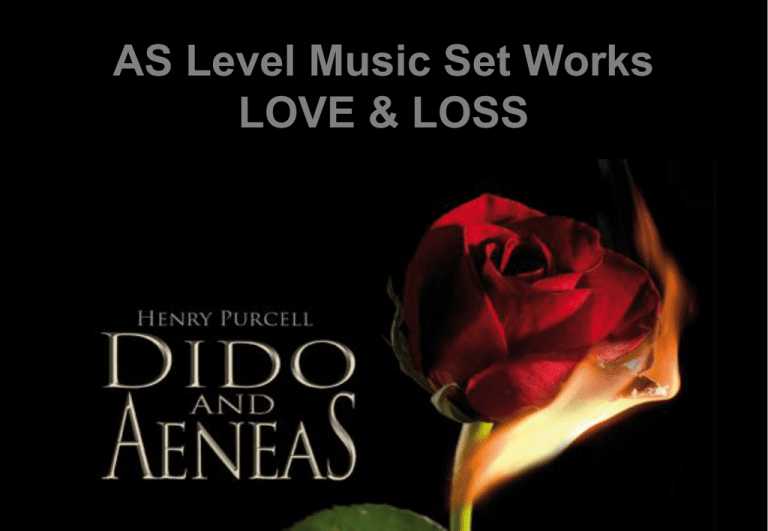
AS Level Music Set Works LOVE & LOSS ANALYSIS OF THE OPERA Whilst we don’t need to analyze the Opera in huge detail, it helps to understand some of the forms of the more important arias and movements. SCENE 1 No. 1 – Shake the Cloud Belinda sings a short aria (accompanied by continuo) to cheer Dido up. From the first word, Purcell sets the text to music by word-painting – the dotted rhythm lending a ‘shakiness’ to the word ‘shake’. Similarly the word ‘flowing’ has a long flowing setting. The chorus (who act as commentators in the opera) then take up a homophonic chorus to emphasize the message. ANALYSIS OF THE OPERA Whilst we don’t need to analyze the Opera in huge detail, it helps to understand some of the forms of the more important arias and movements. SCENE 1 No. 2 - “Ah! Belinda” This aria is in C Minor to depict angiush and the tragedy of Dido’s situation. Time Signature = 3/4 Form = AABCB Style = Declamatory Air/Aria Sung by = Dido First Section = AA 4 Bar Ground Bass, played 21 times throughout song. ANALYSIS OF THE OPERA First Section (AA Continued): 4 Bar Ground Bass, played 21 times throughout song. Purcell uses the same harmonic pattern - repeated every 4 bars ending with a strong V-I cadence (except for 2 repetitions in the dominant key, the 12 and 13th repeat). ANALYSIS OF THE OPERA Opening Phrases The first vocal phrase contains the words “Ah! Belinda” and lasts 4 bars: The second vocal phrase contains the words “I am prest with torment” and lasts 3 bars: The shortening of the second phrase to 3 bars lends weight to the word ‘prest’ as the notes are literally pressed into a smaller space. ANALYSIS OF THE OPERA Opening Phrases The third vocal phrase contains both couplets (“Ah! Belinda I am prest with torment not to be confest”) and lasts 9 bars: These differing phrase lengths serve to OFFSET the repetition of the Ground Bass pattern of 4 bars. Notice how they start in differing bars of the ground bass. All 3 phrases are then repeated forming the AA part of the structure. NOTICE how Dido’s vocal line is MUCH grander then Belinda’s – which fits her status. ANALYSIS OF THE OPERA Opening Phrases These differing phrase lengths serve to OFFSET the repetition of the Ground Bass pattern of 4 bars in the AA section of the aria. Second Section of the Song: This section forms the round BCB part of the structure. The first phrase is 4 bars long, and begins one bar BEFORE the ground bass pattern: ANALYSIS OF THE OPERA Second Section of the Song: The second phrase repeats, although note how, as Dido and Peace become strangers, so too does the melody line and ground bass, which were together in the previous phrase. The next phrase is four bars long (the C section) and coincides with the bass which has now been transposed to the DOMINANT. ANALYSIS OF THE OPERA Second Section of the Song: This phrase is then repeated, with a very long melisma on the word LANGUISH, which serves to emphasise the meaning of the word. The aria finishes with a double lined repetition of the phrase “Peace and I are strangers grown” to give it a sense of finishing, which also coincides with the Cadence in the Ground Bass. ANALYSIS OF THE OPERA SCENE 1 No. 3 - “Grief increases by Concealing” This recitative (sung by Belinda, with one interjection by Dido) follows immediately from the end of the previous aria. It opens sparsely accompanied (recitativo secco) and then becomes more closely accompanied (recitativo accompagnato) Belinda here exposes Dido’s secret desire for Aeneas. The chorus, yet again commenting, enter with “when monarchs unite”. In a cheerful, homophonic chorus – they comment that such a marriage would be desirable politically. ANALYSIS OF THE OPERA SCENE 1 No. 5 - “Whence could so much Virtue Spring” Dido reveals that she might just harbour feelings for Aeneas, and paints a picture of a brave, yet sensitive, hero. This is especially evident in the contrast of Purcell’s setting of the words “valour”, with a forte melisma... and “soft”, with a sudden piano line. This is followed by Belinda, and the ‘spokeswoman’ from the chorus, joining in a duet reassuring Dido that Aeneas will love her just as much. (“Fear no danger, to ensue”). ANALYSIS OF THE OPERA SCENE 1 No. 6 – “Fear no Danger to Ensue” After the opening section duet, the chorus join in, to emphasise the point. Purcell often includes some ‘balletic’ writing in the songs. The most obvious example of this is this Duet and Chorus Fear No Danger to Ensue - it is the most ‘Frenchified’ of the numbers in the opera with its lilting dance style: Note also in this duet and chorus, the inclusion of G Minor - Dido’s death key - which seems cruelly ironic in a song celebrating the triumph of her final acceptance of love. ANALYSIS OF THE OPERA SCENE 2 No. 7 – “See See Your Royal Guest Appears” This recitative begins in a simple style – with Belinda heralding the arrival of Aeneas with a fanfare-like pattern based on a C Major triad. Aeneas’ first line in the opera is to immediately flirt with Dido “When, Royal fair, shall I be blest…?” Dido still tries to hold his advances at bay, however: “Fate forbids what you pursue”, answered by Aeneas (surely the greatest pick-up line ever!): “Aeneas has no fate but you…” – suggesting he will abandon his mission (given by the Gods) to rebuild Troy. ANALYSIS OF THE OPERA SCENE 2 No. 8 – “Cupid Only Throws the Dart” This chorus (another commentary from them) begins with imitative entries from Soprano down to Bass. It is in E minor, and they are singing about the power of love (as it here has postponed Aeneas mission to rebuild Troy). After intricately weaving a polyphonic passage the chorus comes together for a homophonic ending to the chorus. ANALYSIS OF THE OPERA SCENE 2 No. 9 – “If not for mine, for Empire’s sake” Aeneas, in this recitative, is pleading his case for Dido’s love. Purcell assures us that things are going well in this quest, by taking us back from E minor to G Major at the end of this short passage. Note the very strong word-painting on the word fall. ANALYSIS OF THE OPERA SCENE 2 No. 10 – “Pursue Thy Conquest” This continuo Aria (sung by Belinda, who lends the final encouragement to Dido to fall in love) begins with a descending scale and cadence into the home-key for this second scene (C Major): Belinda confirms in this aria Dido’s unspoken response with the words “her eyes confess the flame her tongues denies”. Act one ends with cheerful celebration – a Triumphing Dance in C Major. ANALYSIS OF THE OPERA SCENE 6 No. 37 “When I am Laid in Earth” (Dido’s Lament) This aria is in G Minor and is the masterpiece of the Opera. Time Signature = 3/2 Form = AB (Binary) Style = Lament Sung by = Dido First Section = A The ground bass is UNUSUAL as it is irregular (5 bars) in length. ANALYSIS OF THE OPERA First Section = A The ground bass patterns descends CHROMATICALLY through a 4th It then makes a cadence leap through the lower octave of G minor. Over the ground bass, the vocal phrase is 9 bars on length: Notice how the vocal line strives continually UPWARDS over the chromatic descending nature of the ground bass, depicting the struggle of Dido as she succumbs to her impending fate. ANALYSIS OF THE OPERA First Section = A The A section - “When I am laid in earth may my wrongs create no trouble for the breast” is repeated. Second Section = B The second section is the setting of the words “Remember me! But ah! Forget my fate”. Notice how this begins on a D, and hovers around the D, creating tension as D is the dominant note of the G Minor key of the aria. It therefore lends expectation to the sound. ANALYSIS OF THE OPERA Second Section = B This expectation is realised when finally, on the 3rd desperate “Remember me!” the melody line leaps up to a high G (the tonic). Then, as her final statement (repeated), Dido sings a descending diatonic scale, ending on the tonic G, cadencing with the ground bass: Note the repeat is NOT in the score. ANALYSIS OF THE OPERA Second Section = B As Dido dies (in the instrumental at the end of the lament), the violins play the full descending chromatic scale from G down to G (ending on the first chord of the final chorus “With Drooping Wings”. This full G minor descending chromatic scale provides one of the most beautiful and heart-rending moments in opera, as Dido lays down for the last time. ANALYSIS OF THE OPERA Examples from Dido’s Lament of Purcell’s mastery of his art: • The ground bass repeats strictly, whilst the vocal line varies, avoiding dull repetition. • Purcell successfully combines both chromatic and diatonic scales • Purcell creates a sense of the impending demise by including the descending chromatic scale, but NEVER in its full form (throughout the aria it ends on D, the dominant, rather than the tonic). UNTIL the final descending chromatic scale in the violins, which is fully stated down to the tonic, giving the sense of final realization of the moment to which the aria has been building up. • The vocal line never cadences with the ground bass until the end of Dido’s vocal line, when she dies. It is simple, magic musical writing. Other repeating features…. Other examples of Purcell’s compositional style: Dance Movements There are two reasons why Purcell has included dance-music in his Opera. 1) The fashion in France at the time was for ‘balletic’ operas, and Purcell clearly includes some influence of this in Dido & Aeneas. The opera includes several dance movements. Sometimes the music for a chorus is repeated and, instead of singing, the chorus dance, and sometimes there is a whole separate dance movement. ANALYSIS OF THE OPERA Dance Movements The Triumphing Dance (No. 12), The Echo Dance of Furies (No. 21) in the cave scene and the Sailor's Dance at the harbour (No. 29) are examples of this. It is thought that there was more dance music to start with, but some of it was lost. 2) The second reason for Purcell’s inclusion of dance is that the opera was written as a commission for a London Girls’ School by a Mr Josias Priest, who was the dance master - therefore it was felt a lot of dance movements were appropriate. It is thought that, because it was written for a Girls’ School, the Tenor and Bass parts were added in a later revision of the score. ANALYSIS OF THE OPERA The rhythmic setting of “Fear no Danger to Ensue” with crotchet minim - minim - crotchet (alternating the stress on 1st and 3rd beats) is almost identical to Jean-Baptiste Lully’s “Ballet des nations” and “Les adamants magnifigues”. Lully was a French baroque composer. Word Painting Purcell believed that music is “the exaltation of poetry” and he displays this often in has clever setting of Tate’s text. Melismas offer performers great opportunity for personal expression. Purcell writes complex melismas to emphasise key words such as torment, pity, and sorrow. Example from No. 36 - Word: Darkness from “Thy Hand Belinda”. ANALYSIS OF THE OPERA Word Painting In “Whence Could So Much Virtue Spring” (No. 5) Purcell colours words such as “storm”: ….and also “fierce”: These contrast with “soft” in the same recitative with its ‘p’ marking and sighing descending semitone: And that’s Dido & Aeneas, in a nutshell. :-)
